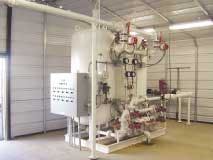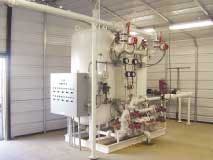By Mark Reinsel
A treatment system is planned for the Carter Chouteau County Water and Sewer District, a small rural utility in Montana, to remove arsenic to below the new maximum contaminant level (MCL) of 10 mg/L, which becomes effective in 2006. During a recent research program, several treatment alternatives were considered. All had to comply with the 1996 Safe Drinking Water Act and design standards specified in Montana Circular DEQ 1.
The design basis was 200,000 gpd, which is the estimated peak daily demand in 2023. This is based on 80 households and a population of 220 in 2023. Operating costs were based on an average daily demand of 103,000 gpd in 2003. The current arsenic level is approximately 30 ug/L.
On October 31, 2001, the USEPA Administrator finalized the maximum contaminant level (MCL) of 10 ug/L (ppb) for arsenic. The MCL compliance date is January 23, 2006, which means that all community and transient noncommunity water systems will then be required to supply water with arsenic levels no greater than 10 ug/L.
Many treatment systems are available for removal of arsenic from water. Historically, most of these technologies were aimed at arsenic removal from industrial waters. However, since lowering of the arsenic MCL has been under discussion for many years, several companies have recently adapted their technologies for use in drinking water. Several new technologies, primarily iron-based adsorption systems, have also been developed to help meet the increased need for a low-cost arsenic removal system.
Based upon the author's experience in this area, along with the recent report "Proven Alternatives for Aboveground Treatment of Arsenic in Groundwater" (EPA 2002), a table was developed to screen technologies using several general criteria. The search was narrowed to five general treatment technologies -- adsorption, precipitation, biological, membrane filtration and ion exchange. Click here to veiw tables.
As the next step in the analysis, more specific arsenic-removal technologies were selected. Four adsorption technologies, three precipitation technologies, and one technology each for biological treatment, membrane filtration and ion exchange were identified. Several of these are "tried-and-true" technologies that have been experimented with and/or used for drinking water treatment since the 1970s: activated alumina (AA), reverse osmosis (RO) and ion exchange (IX).
However, after further investigation, AA, IX and RO were eliminated from consideration at this site because of numerous disadvantages. These disadvantages included:
• All three technologies will only remove As(V). Arsenic at the Carter site is primarily As(III).
• The optimum pH for AA is 5.5-6, which is well below the current pH.
• RO would generate large volumes of concentrated brine and backwash water.
• IX would generate a large volume of brine, and sulfate concentrations at Carter are too high for this technology to be effective.
Seven treatment technologies remained for the final screening process. All of these technologies have been shown to meet the effluent concentration required (less than 10 mg/L) and produce residuals that are classified as non-hazardous waste. All the technologies will also remove both As(III) and As(V), although several require an oxidation process to remove As(III). Most of these technologies are also approved by the National Sanitation Foundation (NSF). A summary is presented in Table 1. Budgetary capital and operating costs were requested from the respective technology vendors.
SMI
Sulfur Modified Iron (SMI) is media containing chemically bonded iron and sulfur, generally 94 to 98 percent iron, with a particle size of 20-80 mesh. Once the media's adsorption capacity is exhausted, it is removed from the vessel and replaced with new media. Spent media will be removed and disposed of by the manufacturer.
SMI will remove both As(III) and As(V) without addition of an oxidizing agent. Frequent "bumping" of the media (by briefly reversing the direction of water flow) is done to minimize short-circuiting through the bed and minimize the pressure drop.
It is estimated that SMI media will need to be replaced every 21 months, based upon the design flow rate of 200,000 gpd, the average usage of 103,000 gpd, and an average arsenic concentration of 30 mg/L. The majority of the operations and maintenance (O&M) cost for SMI is due to media replacement.
A disadvantage of SMI is that as a relatively new technology. It has not yet been used in a full-scale application.
GFH
Granular Ferric Hydroxide (GFH) is a second adsorption process using iron-based media to remove arsenic and other heavy metals from raw water supplies. Spent media will be removed from pressure vessels by the manufacturer and shipped to a non-hazardous waste landfill. GFH is sold by US Filter.
It is estimated that GFH media will need to be replaced every three months. Media life could probably be doubled by operating at a pH of approximately 6.5; however, this would require an acid addition system at a small additional capital cost. The majority of the O&M cost for GFH is due to media replacement. Overall costs are similar to those for SMI.
AD 33
AD 33 is a third iron-based adsorption process. The media is granular ferric oxide rather than ferric hydroxide. This media is lighter than GFH and reportedly requires less contact time for arsenic removal, which reduces the system footprint.
It is estimated that AD 33 media will need to be replaced every nine months. The AD 33 system is geared toward small utilities with design capacities of 10 to 50 gpm, with several of these small full-scale installations in the U.S. Many systems are also in place in Europe, as this technology was developed in Germany.
Estimated costs for AD 33 are identical to those for GFH. Operations would also be similar.
Ferrosand
The Ferrosand process is a type of manganese greensand filtration, which is used for removing soluble iron and manganese from groundwater. It can also remove arsenic in the presence of iron. Chlorine, ferric chloride and potassium permanganate are used to oxidize and precipitate arsenic. These precipitates are then captured in the filter media. Greensand is made from glauconite, a green, iron-rich, clay-like mineral that usually occurs as small pellets mixed with other sand particles. The greensand is continuously regenerated through addition of potassium permanganate.
Ferrosand will remove both As(III) and As(V). O&M costs are low since media replacement is not required - the primary costs are for chemicals and power.
Macrolite
The Macrolite process, developed by Kinetico of Newbury, OH, is a type of enhanced ferric iron coagulation. It combines oxidation, coagulation and filtration. Macrolite media (40x60 mesh) is a proprietary ceramic material specifically designed for drinking water filtration. The chemicals required are sodium hypochlorite and ferric chloride. A five-minute mixing time is provided in a reactor prior to filtration.
Hypochlorite addition is required to oxidize and remove As(III), which is the primary species at this site. The Macrolite process comes with a performance guarantee.
eVox
The eVox process, developed by Watermark Technologies of Sandy, UT, is another type of enhanced ferric iron coagulation. The eVox system uses garnet filtration media. The chemicals required are sodium hypochlorite and ferric chloride. The process reportedly boosts standard coagulation efficiency through "advanced energy transfer." A several-minute reaction time is provided in a reactor prior to filtration.
Operations are similar to the Macrolite process and the eVox process also comes with a performance guarantee.
ABMet
The ABMet process, developed by Applied Biosciences of Salt Lake City, UT, uses biological sulfate reduction to precipitate arsenic and heavy metals. An organic nutrient would continuously be added to feed the bacteria. The system would require approximately a six-hour retention time.
This system requires very little maintenance; the nutrient comprises the majority of the O&M cost. However, the process is not NSF-approved and has not yet been used beyond the pilot scale. In addition, post-treatment for drinking water (aerobic bacterial polishing, followed by filtration and disinfection) has not yet been developed.
Selected Alternatives
The seven treatment alternatives developed were reduced to three viable alternatives based on the following criteria.
Cost-Effectiveness
Table 3 presents a cost comparison of the seven alternatives. Total capital costs include equipment costs from Table 2, plus engineering and installation (site work, building, piping, tanks, electrical and miscellaneous). Present worth costs, based on an interest rate of six percent, are also shown.
The eVox system has the lowest capital costs due to the lowest cost for water treatment equipment. Its annual O&M cost is slightly higher than the Ferrosand or Macrolite processes, which narrows the gap when comparing present worth for these three alternatives.
The ABMet process can be eliminated for several reasons - highest capital cost, highest present worth, largest footprint required, and the fact that it is unproven for drinking water at any scale. The adsorption technologies (SMI, GFH and AD 33) were also eliminated because of their much higher present worth costs. To achieve similar performance for arsenic removal, the present worth of these technologies is each approximately $1.3 million, compared to between $900,000 and $1 million for the precipitation technologies. On a present worth basis, Ferrosand, Macrolite and eVox are the most cost-effective alternatives.
Treatment Performance
The Ferrosand process is designed specifically for manganese and iron removal. Since water at this site contains very little iron, iron removal is not a concern; in fact, iron must be added to remove arsenic as an iron hydroxide coprecipitate. The process has also been proven in many full-scale applications. Therefore, removal of arsenic to below the required concentrations is expected to be relatively straightforward. Pilot testing would be useful but it may not be necessary.
The Macrolite process has been used in many drinking water applications but not specifically for arsenic removal. Although the manufacturer provides a performance guarantee, the process should be pilot-tested before deciding on a full-scale system.
The eVox process is a very similar technology to the Macrolite process. This system has not been evaluated beyond the pilot scale. This system should also be pilot-tested.
Operation and Maintenance
All three of the selected technologies have similar operations and maintenance requirements. Each filter will be backwashed approximately once per day (probably automatically), and none will require media replacement for at least 10 years. Each requires the addition of two or three chemicals. The residuals from each process would be similar -- backwash water and sludge (primarily iron hydroxide).
Pilot Testing
A Ferrosand pilot unit is available to rent for $250/month. A pilot test, including start-up expenses, process support and analytical costs, would cost approximately $5,000. It was recommended to operate a two-month pilot test with all three technologies running concurrently.
For the Macrolite process, a standard pilot test protocol has been developed by the manufacturer. The total pilot cost, including equipment rental, shipping and analysis, would be approximately $6,000.
For the eVox process, the vendor recommends operating an intensive one-week pilot test, with the manufacturer present for start-up and operation. The plant operator at the site would also be able to gain experience with the system during this time. The eVox pilot test could be run concurrently with the other two pilots. The approximate cost of an eVox pilot is $5,000.
About the Author: Mark Reinsel, Ph.D., P.E., is president of Apex Engineering, PLLC, a small consulting firm in Helena, Montana. Reinsel has 20 years of experience in consulting, industry and academia. His recent projects have focused on treating drinking water and industrial wastewaters through chemical, physical and biological methods (both active and passive).




